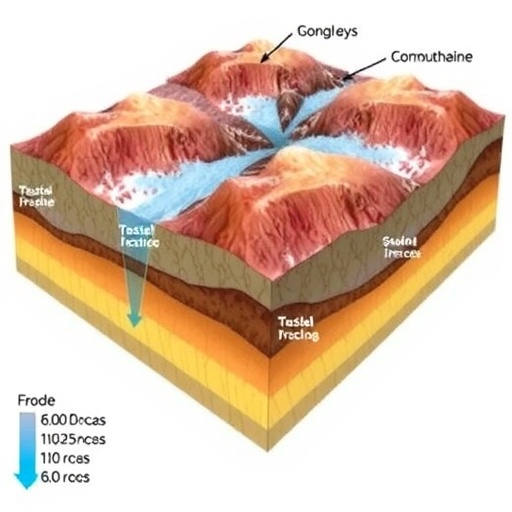The Earth’s surface is a constantly evolving interface shaped by dynamic processes operating over vast timescales. Among the many forces that sculpt our planet’s landscape, glacial cycles stand out as powerful agents of transformation, driving profound changes in climate, sea level, and tectonic activity throughout the Quaternary period. Recent advances in geophysical modeling have unveiled a previously underappreciated connection between glaciation, lithospheric motion, and mid-ocean ridge spreading. This emerging paradigm provides a fresh lens through which to view the interplay of ice ages with the fundamental tectonic mechanisms that shape the Earth’s crust.
Glacial cycles—periods of extensive ice sheet growth and subsequent retreat—have long been recognized for their role in modulating global climate and inducing sea-level fluctuations. However, the influence of these cycles on the solid Earth, particularly on lithospheric plates beneath the surface, has remained elusive. The lithosphere, comprising the crust and the upper mantle, behaves as a rigid shell floating atop the more ductile asthenosphere. Its motion governs plate tectonics, mantle convection, and volcanic activity. The recent work by Yuan and Zhong shines a spotlight on how these slowly evolving ice masses can perturb the lithosphere at scales comparable to those of tectonic plate motions.
Utilizing high-resolution numerical simulations, the researchers incorporated realistic lithospheric structures into their models, capturing variations in crust and mantle thickness, as well as areas of structural weakness such as plate boundaries. These advanced models are not simplistic approximations; rather, they refine our understanding by integrating geophysical complexities like anisotropy and spatial heterogeneity. The team specifically probed how glacial forcing—associated with growing and melting ice sheets—affects lithospheric rotation and horizontal motion over millennial timescales.
Moreover, the study highlights the interplay between glaciation and mid-ocean ridge dynamics, particularly at the Iceland Ridge, a spreading center interacting closely with remnant ice sheets from Greenland and Fennoscandia. Between 12,000 and 6,000 years ago, fluctuations in ice mass loading corresponded with changes in spreading rates of up to 40%. This significant variability likely contributed to the volcanic activity observed across Iceland during the Holocene, linking surface ice cycles directly to melt generation and magma transport in the mantle.
These discoveries open a new frontier in understanding the feedback loops between surface climate processes and deep Earth dynamics. As ice sheets grow, they depress the crust and inhibit underlying mantle upwelling, slowing the creation of new oceanic crust at ridges. Conversely, deglaciation relieves lithospheric loading, enhancing mantle decompression and accelerating seafloor spreading. This mechanism, previously overlooked, may have implications for global mantle degassing rates, which influence atmospheric composition and climate regulation.
Technologically, the study leverages state-of-the-art computational resources to simulate coupled ice-lithosphere interactions with unprecedented detail. Incorporating weak plate margins and varying lithospheric thickness refines predictive capabilities, closely matching observational datasets such as GPS measurements of crustal deformation and volcanic eruption records. This synergy between numerical modeling and empirical evidence reinforces the credibility of the conclusions and sets a new standard for geodynamic investigations.
Finally, the work underscores the complex dance between Earth’s cryosphere and its internal dynamics, challenging the traditional view that tectonic and climatic systems operate largely independently. Instead, the combined effects of ice load changes and lithospheric response form a vital, yet underexplored, part of the Earth system feedbacks. Going forward, integrating geophysical datasets spanning seismology, volcanology, and paleoclimate will be essential to unravel these intricate relationships and predict their future trajectories in a warming world.
As humanity continues to grapple with accelerating climate change, understanding the deeper connections between the surface and the planet’s interior gains urgency. The research by Yuan and Zhong not only fills a crucial gap in geoscientific knowledge but also offers new clues on how past Earth processes might inform future geodynamic and climatic behavior. Their findings, published in Nature, mark a significant step toward decoding the Earth’s subtle but powerful responses to the waxing and waning of ice.
Subject of Research: Effects of glacial forcing on lithospheric motion and mid-ocean ridge spreading during Quaternary glacial cycles.
Article Title: Effects of glacial forcing on lithospheric motion and ridge spreading.
Article References:
Yuan, T., Zhong, S. Effects of glacial forcing on lithospheric motion and ridge spreading. Nature (2025). https://doi.org/10.1038/s41586-025-08846-x
Image Credits: AI Generated
Tags: evolution of Earth’s surface processesgeophysical modeling of Earth processesglacial cycles impact on lithosphere movementinfluence of ice sheets on Earth’s crustlithosphere and asthenosphere interactionsmid-ocean ridge spreading dynamicsnumerical simulations in geologyQuaternary climate change effectsrelationship between ice ages and tectonicssea level fluctuations during glaciationtectonic activity and glaciationtectonic plates and climate connection





